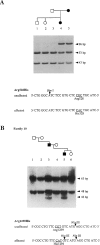Abstract
Hypokalemic periodic paralysis (hypoPP) is an autosomal dominant disorder belonging to a group of muscle diseases involving the abnormal function of ion channels. This group of muscle diseases also comprises hyperkalemic periodic paralysis and paramyotonia congenita, both sodium-channel diseases, and myotonia congenita, a chloride-channel disorder. HypoPP is characterized by acute attacks of muscle weakness concomitant with a fall in blood potasium levels. We recently localized the hypoPP locus (hypoPP1) to chromosome 1q31-32, in an interval where the α1 subunit of the dihydropyridine receptor calcium channel (CACNL1A3) also maps. Subsequently, deleterious mutations in the voltage-sensor segment S4 were found, establishing the dihydropyridine receptor CACNL1A3 as the causative gene for hypoPP. In this paper, we report the study of 16 hypoPP families of Caucasian origin. We found only two mutations—Arg528His and Arg1239His—that cosegregated with hypoPP, each in half of the families. Analysis of the clinical characteristics of both groups of families demonstrated that incomplete penetrance is a distinctive feature of the Arg528His mutation. Using dinucleotide repeats contained within or close to the dihydropyridine receptor gene, in conjunction with evidence of a de novo Arg1239His mutation, we show that a founder effect is unlikely to account for the two predominant mutations.
Full text
PDF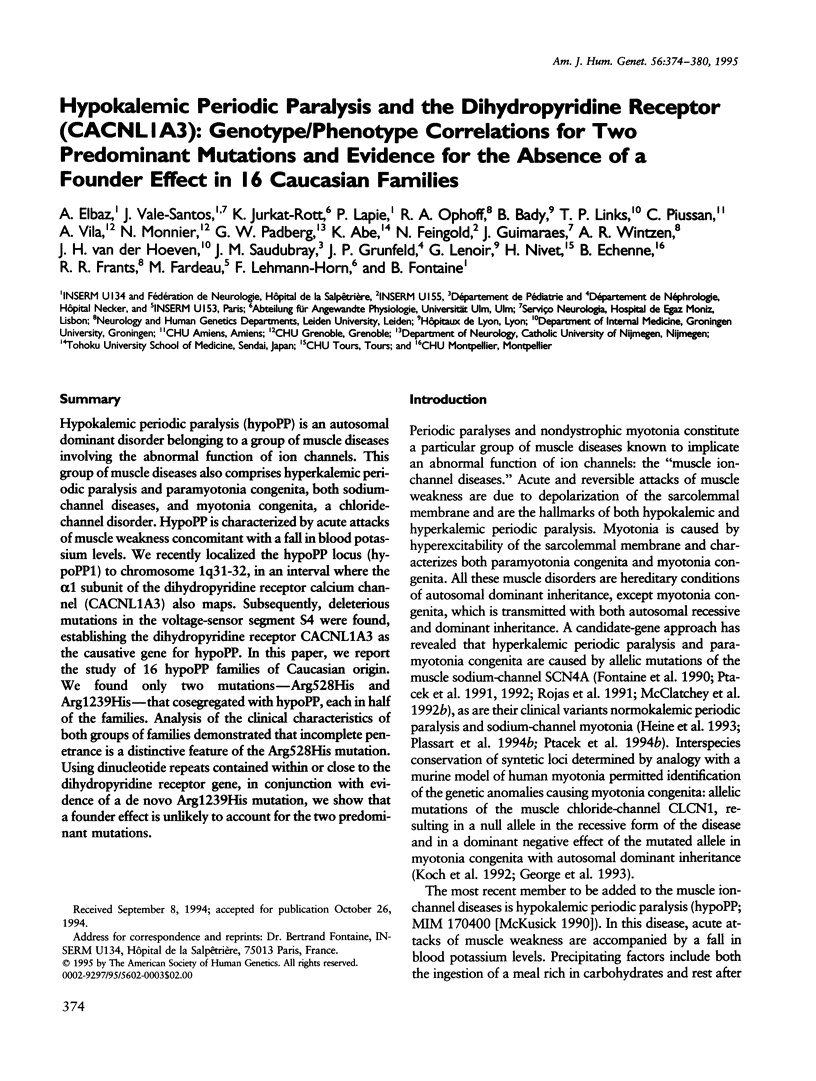
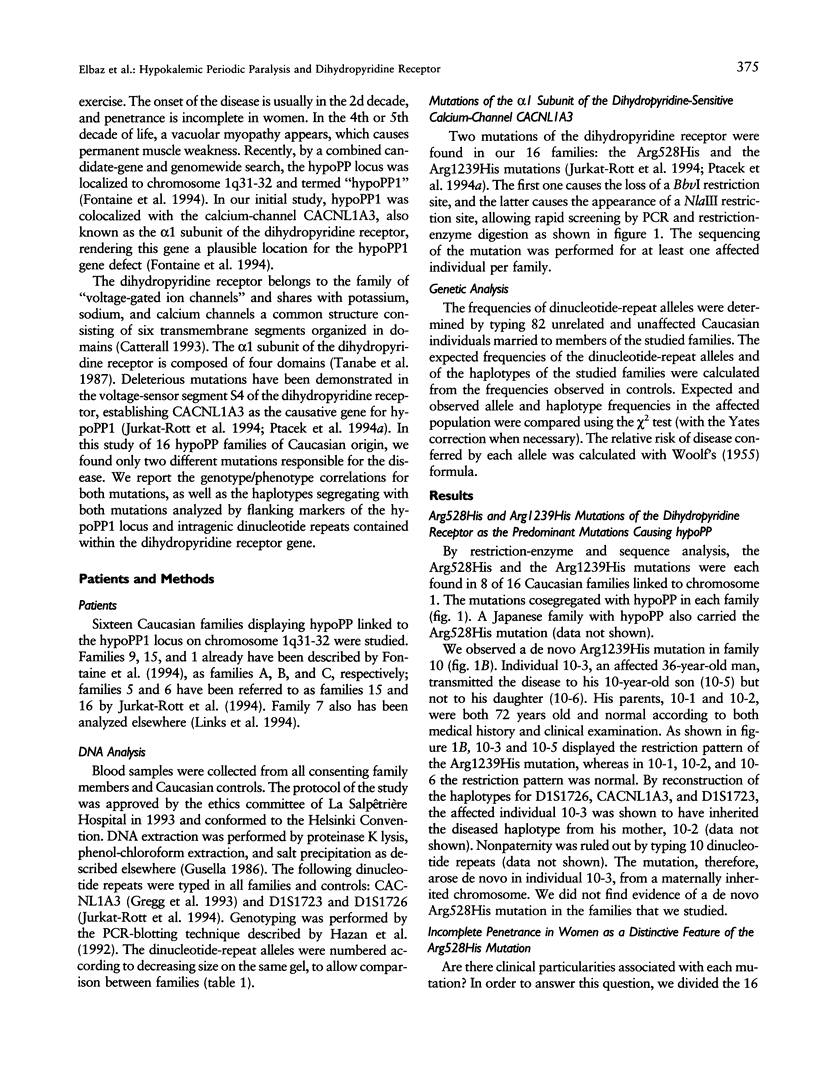
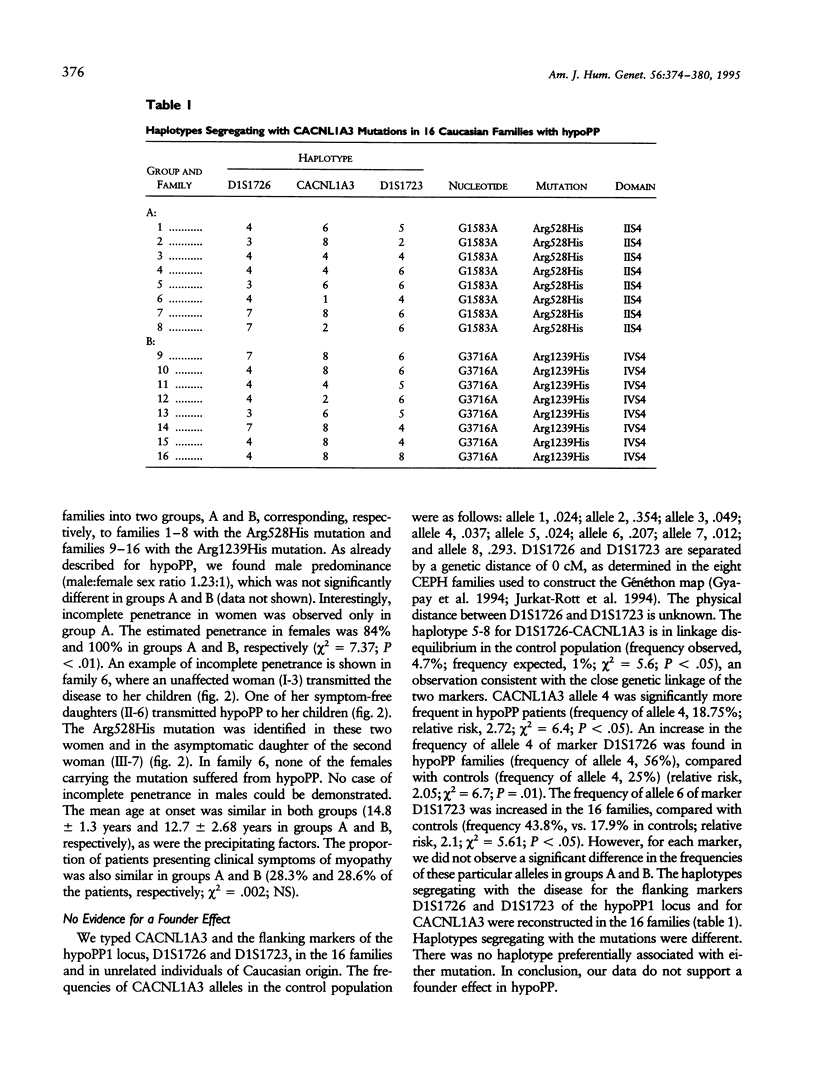
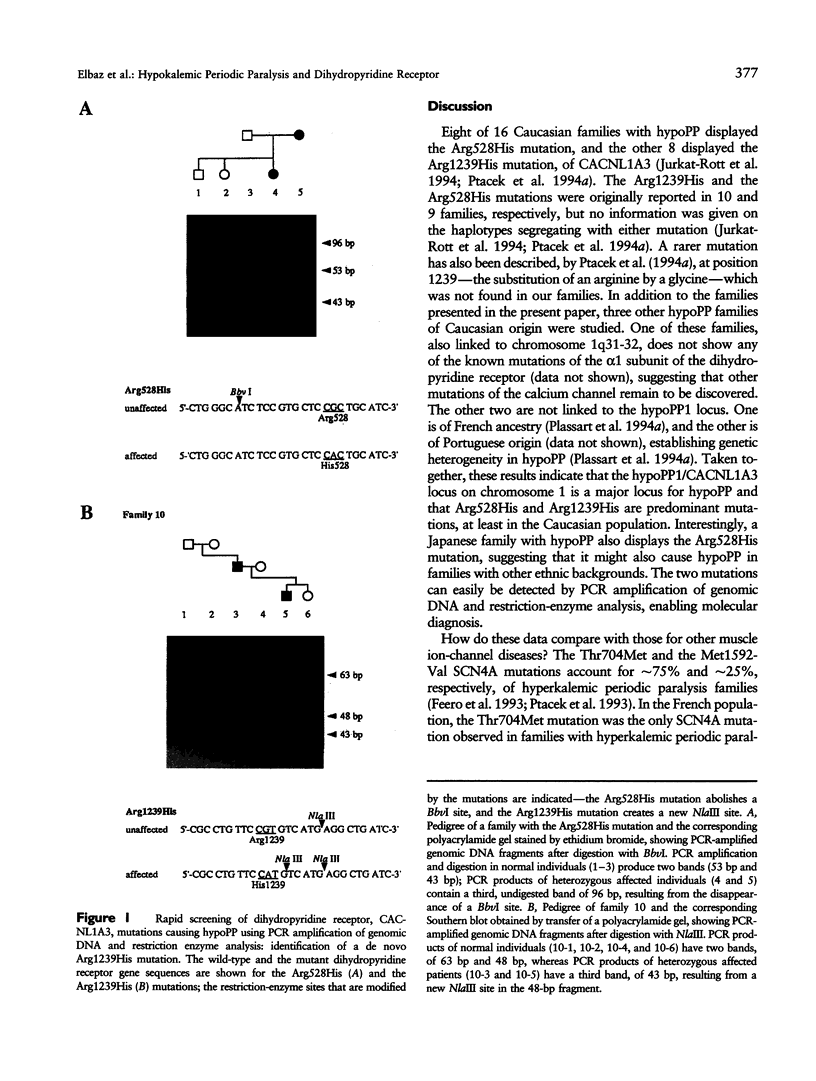
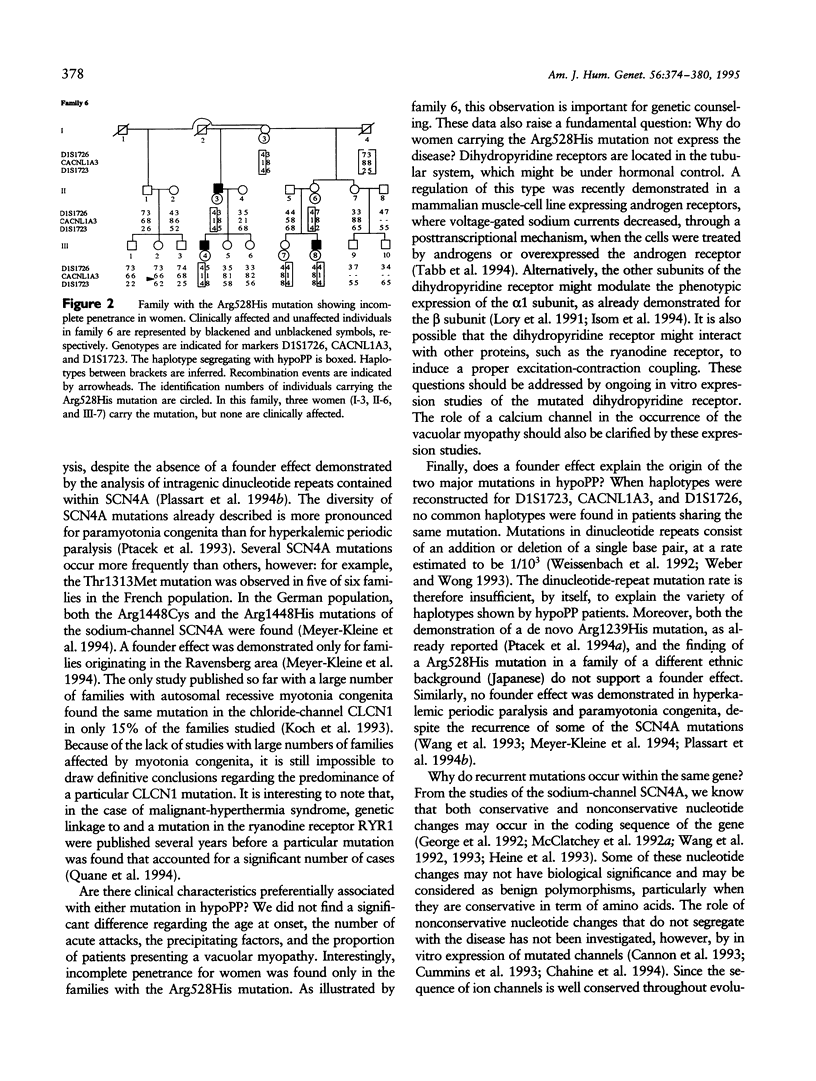
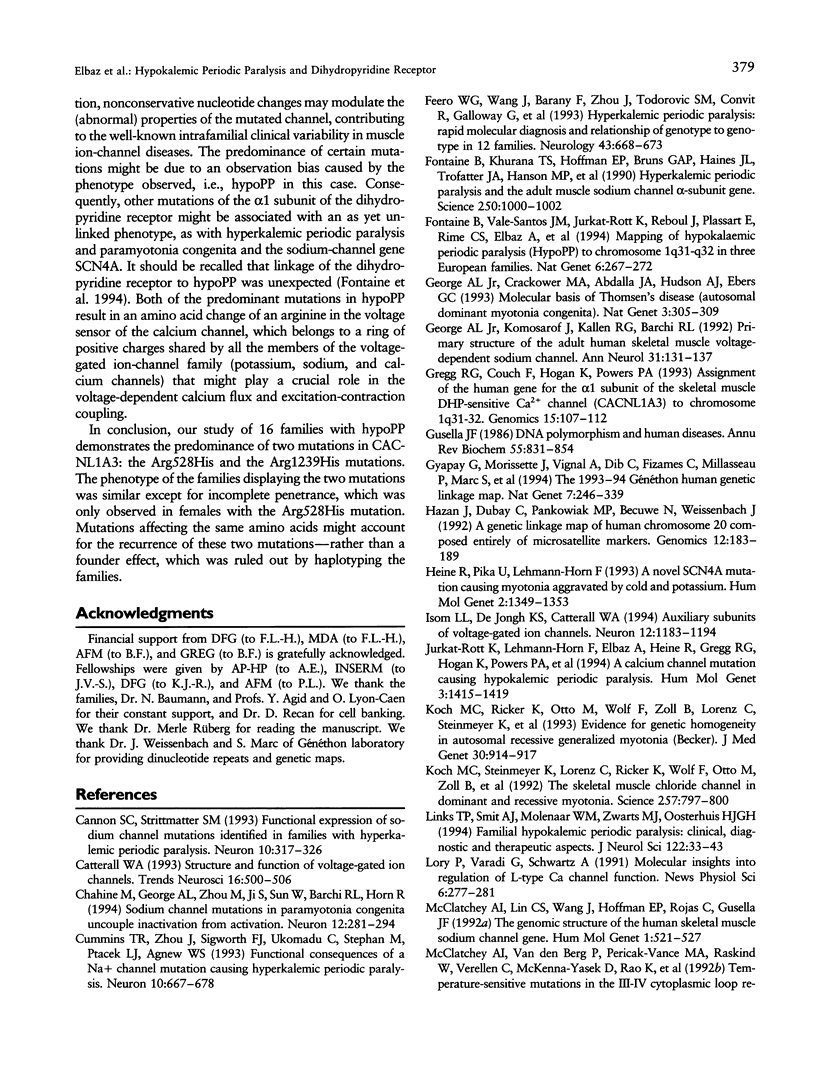
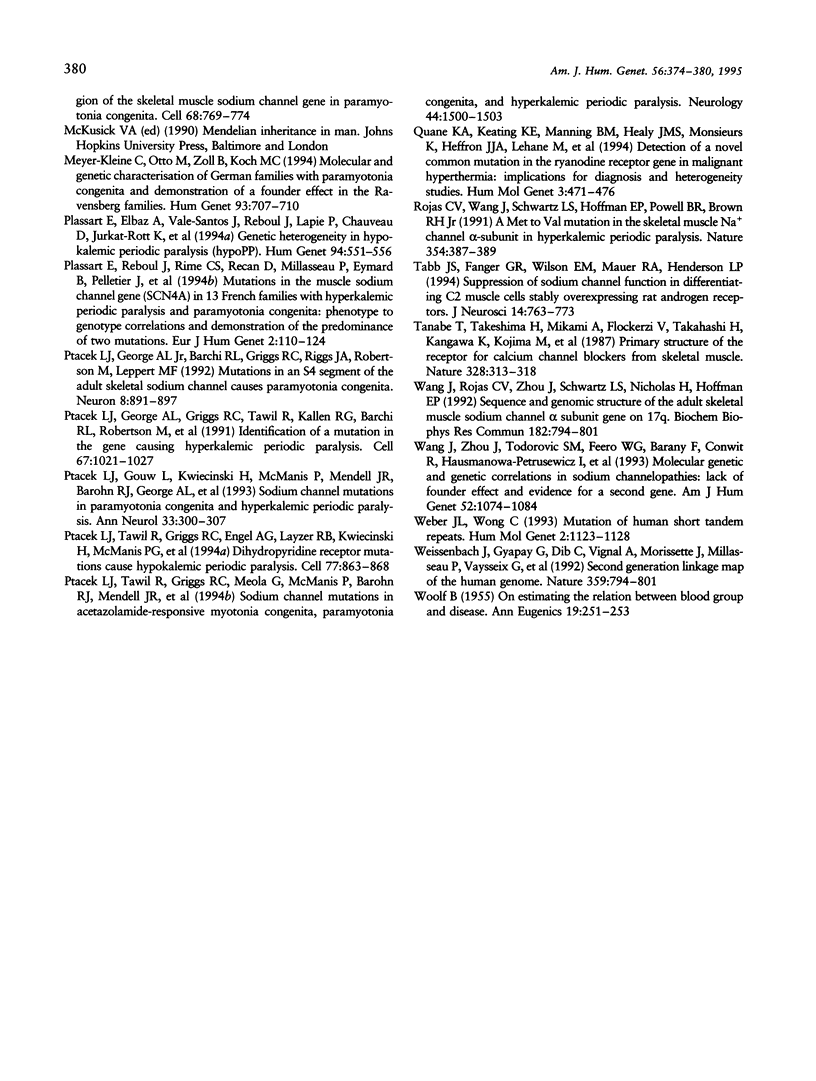
Images in this article
Selected References
These references are in PubMed. This may not be the complete list of references from this article.
- Cannon S. C., Strittmatter S. M. Functional expression of sodium channel mutations identified in families with periodic paralysis. Neuron. 1993 Feb;10(2):317–326. doi: 10.1016/0896-6273(93)90321-h. [DOI] [PubMed] [Google Scholar]
- Catterall W. A. Structure and function of voltage-gated ion channels. Trends Neurosci. 1993 Dec;16(12):500–506. doi: 10.1016/0166-2236(93)90193-p. [DOI] [PubMed] [Google Scholar]
- Chahine M., George A. L., Jr, Zhou M., Ji S., Sun W., Barchi R. L., Horn R. Sodium channel mutations in paramyotonia congenita uncouple inactivation from activation. Neuron. 1994 Feb;12(2):281–294. doi: 10.1016/0896-6273(94)90271-2. [DOI] [PubMed] [Google Scholar]
- Cummins T. R., Zhou J., Sigworth F. J., Ukomadu C., Stephan M., Ptácek L. J., Agnew W. S. Functional consequences of a Na+ channel mutation causing hyperkalemic periodic paralysis. Neuron. 1993 Apr;10(4):667–678. doi: 10.1016/0896-6273(93)90168-q. [DOI] [PubMed] [Google Scholar]
- Feero W. G., Wang J., Barany F., Zhou J., Todorovic S. M., Conwit R., Galloway G., Hausmanowa-Petrusewicz I., Fidzianska A., Arahata K. Hyperkalemic periodic paralysis: rapid molecular diagnosis and relationship of genotype to phenotype in 12 families. Neurology. 1993 Apr;43(4):668–673. doi: 10.1212/wnl.43.4.668. [DOI] [PubMed] [Google Scholar]
- Fontaine B., Khurana T. S., Hoffman E. P., Bruns G. A., Haines J. L., Trofatter J. A., Hanson M. P., Rich J., McFarlane H., Yasek D. M. Hyperkalemic periodic paralysis and the adult muscle sodium channel alpha-subunit gene. Science. 1990 Nov 16;250(4983):1000–1002. doi: 10.1126/science.2173143. [DOI] [PubMed] [Google Scholar]
- Fontaine B., Vale-Santos J., Jurkat-Rott K., Reboul J., Plassart E., Rime C. S., Elbaz A., Heine R., Guimarães J., Weissenbach J. Mapping of the hypokalaemic periodic paralysis (HypoPP) locus to chromosome 1q31-32 in three European families. Nat Genet. 1994 Mar;6(3):267–272. doi: 10.1038/ng0394-267. [DOI] [PubMed] [Google Scholar]
- George A. L., Jr, Crackower M. A., Abdalla J. A., Hudson A. J., Ebers G. C. Molecular basis of Thomsen's disease (autosomal dominant myotonia congenita). Nat Genet. 1993 Apr;3(4):305–310. doi: 10.1038/ng0493-305. [DOI] [PubMed] [Google Scholar]
- George A. L., Jr, Komisarof J., Kallen R. G., Barchi R. L. Primary structure of the adult human skeletal muscle voltage-dependent sodium channel. Ann Neurol. 1992 Feb;31(2):131–137. doi: 10.1002/ana.410310203. [DOI] [PubMed] [Google Scholar]
- Gregg R. G., Couch F., Hogan K., Powers P. A. Assignment of the human gene for the alpha 1 subunit of the skeletal muscle DHP-sensitive Ca2+ channel (CACNL1A3) to chromosome 1q31-q32. Genomics. 1993 Jan;15(1):107–112. doi: 10.1006/geno.1993.1017. [DOI] [PubMed] [Google Scholar]
- Gusella J. F. DNA polymorphism and human disease. Annu Rev Biochem. 1986;55:831–854. doi: 10.1146/annurev.bi.55.070186.004151. [DOI] [PubMed] [Google Scholar]
- Gyapay G., Morissette J., Vignal A., Dib C., Fizames C., Millasseau P., Marc S., Bernardi G., Lathrop M., Weissenbach J. The 1993-94 Généthon human genetic linkage map. Nat Genet. 1994 Jun;7(2 Spec No):246–339. doi: 10.1038/ng0694supp-246. [DOI] [PubMed] [Google Scholar]
- Hazan J., Dubay C., Pankowiak M. P., Becuwe N., Weissenbach J. A genetic linkage map of human chromosome 20 composed entirely of microsatellite markers. Genomics. 1992 Feb;12(2):183–189. doi: 10.1016/0888-7543(92)90364-x. [DOI] [PubMed] [Google Scholar]
- Heine R., Pika U., Lehmann-Horn F. A novel SCN4A mutation causing myotonia aggravated by cold and potassium. Hum Mol Genet. 1993 Sep;2(9):1349–1353. doi: 10.1093/hmg/2.9.1349. [DOI] [PubMed] [Google Scholar]
- Isom L. L., De Jongh K. S., Catterall W. A. Auxiliary subunits of voltage-gated ion channels. Neuron. 1994 Jun;12(6):1183–1194. doi: 10.1016/0896-6273(94)90436-7. [DOI] [PubMed] [Google Scholar]
- Jurkat-Rott K., Lehmann-Horn F., Elbaz A., Heine R., Gregg R. G., Hogan K., Powers P. A., Lapie P., Vale-Santos J. E., Weissenbach J. A calcium channel mutation causing hypokalemic periodic paralysis. Hum Mol Genet. 1994 Aug;3(8):1415–1419. doi: 10.1093/hmg/3.8.1415. [DOI] [PubMed] [Google Scholar]
- Koch M. C., Ricker K., Otto M., Wolf F., Zoll B., Lorenz C., Steinmeyer K., Jentsch T. J. Evidence for genetic homogeneity in autosomal recessive generalised myotonia (Becker). J Med Genet. 1993 Nov;30(11):914–917. doi: 10.1136/jmg.30.11.914. [DOI] [PMC free article] [PubMed] [Google Scholar]
- Koch M. C., Steinmeyer K., Lorenz C., Ricker K., Wolf F., Otto M., Zoll B., Lehmann-Horn F., Grzeschik K. H., Jentsch T. J. The skeletal muscle chloride channel in dominant and recessive human myotonia. Science. 1992 Aug 7;257(5071):797–800. doi: 10.1126/science.1379744. [DOI] [PubMed] [Google Scholar]
- Links T. P., Smit A. J., Molenaar W. M., Zwarts M. J., Oosterhuis H. J. Familial hypokalemic periodic paralysis. Clinical, diagnostic and therapeutic aspects. J Neurol Sci. 1994 Mar;122(1):33–43. doi: 10.1016/0022-510x(94)90049-3. [DOI] [PubMed] [Google Scholar]
- McClatchey A. I., Lin C. S., Wang J., Hoffman E. P., Rojas C., Gusella J. F. The genomic structure of the human skeletal muscle sodium channel gene. Hum Mol Genet. 1992 Oct;1(7):521–527. doi: 10.1093/hmg/1.7.521. [DOI] [PubMed] [Google Scholar]
- Meyer-Kleine C., Otto M., Zoll B., Koch M. C. Molecular and genetic characterisation of German families with paramyotonia congenita and demonstration of founder effect in the Ravensberg families. Hum Genet. 1994 Jun;93(6):707–710. doi: 10.1007/BF00201577. [DOI] [PubMed] [Google Scholar]
- Plassart E., Elbaz A., Santos J. V., Reboul J., Lapie P., Chauveau D., Jurkat-Rott K., Guimaraes J., Saudubray J. M., Weissenbach J. Genetic heterogeneity in hypokalemic periodic paralysis (hypoPP). Hum Genet. 1994 Nov;94(5):551–556. doi: 10.1007/BF00211025. [DOI] [PubMed] [Google Scholar]
- Plassart E., Reboul J., Rime C. S., Recan D., Millasseau P., Eymard B., Pelletier J., Thomas C., Chapon F., Desnuelle C. Mutations in the muscle sodium channel gene (SCN4A) in 13 French families with hyperkalemic periodic paralysis and paramyotonia congenita: phenotype to genotype correlations and demonstration of the predominance of two mutations. Eur J Hum Genet. 1994;2(2):110–124. doi: 10.1159/000472351. [DOI] [PubMed] [Google Scholar]
- Ptacek L. J., Gouw L., Kwieciński H., McManis P., Mendell J. R., Barohn R. J., George A. L., Jr, Barchi R. L., Robertson M., Leppert M. F. Sodium channel mutations in paramyotonia congenita and hyperkalemic periodic paralysis. Ann Neurol. 1993 Mar;33(3):300–307. doi: 10.1002/ana.410330312. [DOI] [PubMed] [Google Scholar]
- Ptácek L. J., George A. L., Jr, Barchi R. L., Griggs R. C., Riggs J. E., Robertson M., Leppert M. F. Mutations in an S4 segment of the adult skeletal muscle sodium channel cause paramyotonia congenita. Neuron. 1992 May;8(5):891–897. doi: 10.1016/0896-6273(92)90203-p. [DOI] [PubMed] [Google Scholar]
- Ptácek L. J., George A. L., Jr, Griggs R. C., Tawil R., Kallen R. G., Barchi R. L., Robertson M., Leppert M. F. Identification of a mutation in the gene causing hyperkalemic periodic paralysis. Cell. 1991 Nov 29;67(5):1021–1027. doi: 10.1016/0092-8674(91)90374-8. [DOI] [PubMed] [Google Scholar]
- Ptácek L. J., Tawil R., Griggs R. C., Engel A. G., Layzer R. B., Kwieciński H., McManis P. G., Santiago L., Moore M., Fouad G. Dihydropyridine receptor mutations cause hypokalemic periodic paralysis. Cell. 1994 Jun 17;77(6):863–868. doi: 10.1016/0092-8674(94)90135-x. [DOI] [PubMed] [Google Scholar]
- Ptáek L. J., Tawil R., Griggs R. C., Meola G., McManis P., Barohn R. J., Mendell J. R., Harris C., Spitzer R., Santiago F. Sodium channel mutations in acetazolamide-responsive myotonia congenita, paramyotonia congenita, and hyperkalemic periodic paralysis. Neurology. 1994 Aug;44(8):1500–1503. doi: 10.1212/wnl.44.8.1500. [DOI] [PubMed] [Google Scholar]
- Quane K. A., Keating K. E., Manning B. M., Healy J. M., Monsieurs K., Heffron J. J., Lehane M., Heytens L., Krivosic-Horber R., Adnet P. Detection of a novel common mutation in the ryanodine receptor gene in malignant hyperthermia: implications for diagnosis and heterogeneity studies. Hum Mol Genet. 1994 Mar;3(3):471–476. doi: 10.1093/hmg/3.3.471. [DOI] [PubMed] [Google Scholar]
- Rojas C. V., Wang J. Z., Schwartz L. S., Hoffman E. P., Powell B. R., Brown R. H., Jr A Met-to-Val mutation in the skeletal muscle Na+ channel alpha-subunit in hyperkalaemic periodic paralysis. Nature. 1991 Dec 5;354(6352):387–389. doi: 10.1038/354387a0. [DOI] [PubMed] [Google Scholar]
- Tabb J. S., Fanger G. R., Wilson E. M., Maue R. A., Henderson L. P. Suppression of sodium channel function in differentiating C2 muscle cells stably overexpressing rat androgen receptors. J Neurosci. 1994 Feb;14(2):763–773. doi: 10.1523/JNEUROSCI.14-02-00763.1994. [DOI] [PMC free article] [PubMed] [Google Scholar]
- Tanabe T., Takeshima H., Mikami A., Flockerzi V., Takahashi H., Kangawa K., Kojima M., Matsuo H., Hirose T., Numa S. Primary structure of the receptor for calcium channel blockers from skeletal muscle. Nature. 1987 Jul 23;328(6128):313–318. doi: 10.1038/328313a0. [DOI] [PubMed] [Google Scholar]
- WOOLF B. On estimating the relation between blood group and disease. Ann Hum Genet. 1955 Jun;19(4):251–253. doi: 10.1111/j.1469-1809.1955.tb01348.x. [DOI] [PubMed] [Google Scholar]
- Wang J. Z., Rojas C. V., Zhou J. H., Schwartz L. S., Nicholas H., Hoffman E. P. Sequence and genomic structure of the human adult skeletal muscle sodium channel alpha subunit gene on 17q. Biochem Biophys Res Commun. 1992 Jan 31;182(2):794–801. doi: 10.1016/0006-291x(92)91802-w. [DOI] [PubMed] [Google Scholar]
- Wang J., Zhou J., Todorovic S. M., Feero W. G., Barany F., Conwit R., Hausmanowa-Petrusewicz I., Fidzianska A., Arahata K., Wessel H. B. Molecular genetic and genetic correlations in sodium channelopathies: lack of founder effect and evidence for a second gene. Am J Hum Genet. 1993 Jun;52(6):1074–1084. [PMC free article] [PubMed] [Google Scholar]
- Weber J. L., Wong C. Mutation of human short tandem repeats. Hum Mol Genet. 1993 Aug;2(8):1123–1128. doi: 10.1093/hmg/2.8.1123. [DOI] [PubMed] [Google Scholar]
- Weissenbach J., Gyapay G., Dib C., Vignal A., Morissette J., Millasseau P., Vaysseix G., Lathrop M. A second-generation linkage map of the human genome. Nature. 1992 Oct 29;359(6398):794–801. doi: 10.1038/359794a0. [DOI] [PubMed] [Google Scholar]



